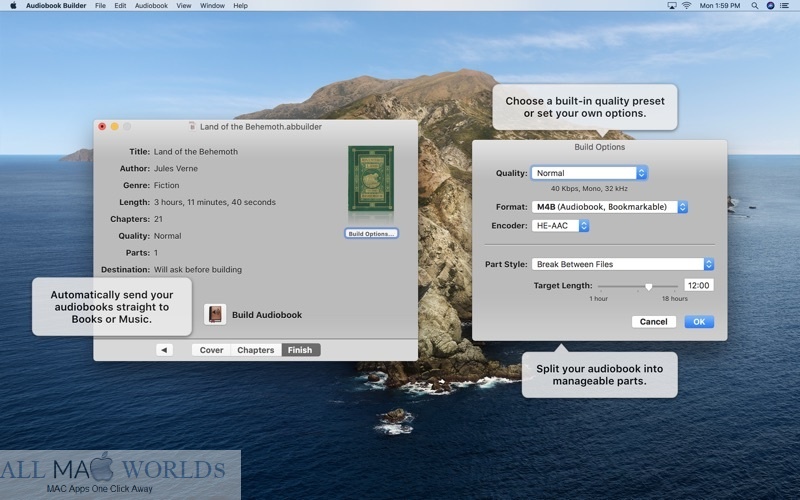


- #AUDIOBOOK BUILDER REDDIT DRIVERS#
- #AUDIOBOOK BUILDER REDDIT UPDATE#
- #AUDIOBOOK BUILDER REDDIT UPGRADE#
- #AUDIOBOOK BUILDER REDDIT FULL#
- #AUDIOBOOK BUILDER REDDIT WINDOWS 10#
That setup was the right choice for my build at the time, and as of this writing, I am still using it. I can go lower (and have, as a test), but settled on this to allow me the best mix of performance and flexibility with some rather hungry plugins.ĥx MOTU MIDI 128, 2x iConnectivity mio XL, many USB->device direct connections I run with a 256 sample buffer which gives me around 5ms round trip.
#AUDIOBOOK BUILDER REDDIT DRIVERS#
MOTU PCIe 424 with 4x 24 i/o rack units (96 inputs, 96 outputs) running at 96k/24 bit (these drivers haven’t been updated in a very long time, so they may stop working at some point in the future). I intend to replace this soon as it’s starting to get on in years.
#AUDIOBOOK BUILDER REDDIT UPGRADE#
I intend to upgrade it once I move to a PCIe 4.0 system in the future) (I’ve had this drive across a few PC upgrades, but it is very fast and reliable. Intel PCIe 1.2TB NVMe drive in a PCIe slot. Driving one 4k 40″ screen and one smaller touch screen NVidia 2080 RTX Super (for video rendering, 3d design, and gaming). I don’t regularly reinstall Windows or do any maintenance.
#AUDIOBOOK BUILDER REDDIT UPDATE#
I tend to update components every 3-5 years, on a rolling basis. That said, my audio latency and performance are quite good, despite having made minimal tweaks.įolks often ask about specs for my own PC, so here are my PC specs at the time of this writing. My own PC is the one I use for everything (video editing and rendering, gaming, software development, 3d CAD/CAM, music creation, general PC use), so I’ve personally made different choices in some cases. I’m making the assumption here that the PC you are tweaking is being used for primarily or exclusively DAW use. Not everyone can do this, but if you can, it’s really a great setup with the best of all worlds. That said, it’s still pretty quiet due to the large fans. I also keep my PC on the other side of a physical wall (cables pass through the wall, which is actually a decoupled double-wall) so I don’t have to consider any tradeoffs with cooling vs noise. Personally, I use a desktop PC for my music creation because that affords me the best performance and expansion options all with the best possible thermal management. a straight list of tweaks.Īlso, some of these tweaks and suggestions will have different implications when on a desktop vs a gaming laptop vs a “thin and light” laptop or tablet. For that reason, the guide here is both longer, and requires more of your active decision making vs. That said, I’ve tried to provide enough information here for you to make informed decisions, rather than blindly following a list of changes. As with any list of “tweaks”, use these at your own risk and expense. I’ve put this out based on my own experience and research. The tweaks and tips here are not necessarily supported by or recommended by Microsoft, the Windows team, or the companies involved in building the hardware and software you are using. It’s important to note again that this is an unofficial guide. I recommend folks not get hung up with test results from DPC latency checkers or others unless there’s an actual audible audio glitch. But I test with my ears, not by using tools. If it’s within the range I want, I’m good. My general approach for audio is to start with the things I know will be important to do, and then test my performance. There are always implications and side effects to any choices you make when customizing a system.
#AUDIOBOOK BUILDER REDDIT FULL#
Why? Because tweak guides should be full of caveats, of course. This tweak/tip guide will be full of caveats. This is important, because so much of the train is set in motion here, at the beginning, when you pick your PC or components. This is part 1, which deals with decisions made before tweaking even starts. Part of the reason for this is that very few tweaks will reliably increase performance across all types of PCs, DAWs, and audio interfaces.īut I felt it’s time to release the things I personally find valuable for a Windows music workstation, in the form of an unofficial and potentially unsupported tweak guide. I’ve avoided releasing a guide like this, because many folks follow tweak guides blindly, and end up with unstable workstations. Some are good, some are quite bad, some are simply outdated, and some suggest things that may ultimately make for a worse-performing workstation. There are many Windows tweak guides out on the net. Part 3: What not to do when tweaking your digital audio workstation.Part 2: What to tweak proactively, and what to consider doing.Part 1: Introduction and PC picking/building.Once available, you will find the other posts here: I hope you find it useful, despite its book-sized text. It started out as a simple list of recommended tweaks, but weeks later, it evolved into this multi-part series.
#AUDIOBOOK BUILDER REDDIT WINDOWS 10#
Windows 10 tweaks, optimizations, and build tips for pro audio workstations / DAWs – Part 1 of 3


 0 kommentar(er)
0 kommentar(er)
